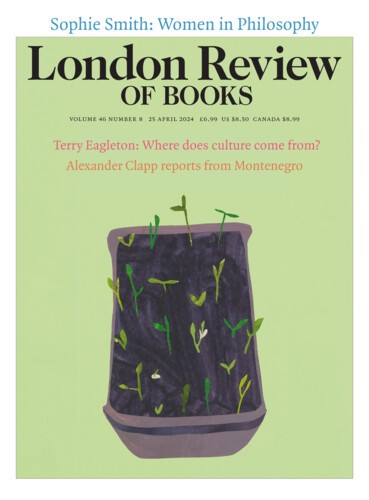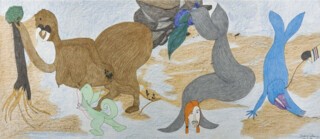Ablue creature – part platypus, part squid, part amorphous squiggle – scuttles behind a pale three-headed figure with one webbed foot. A naked human form being consumed by (or is it wearing? becoming one with?) a large orange octopus stands with an empty box of Kellogg’s cornflakes under one bare foot. A red-haired figure, placid face peeking out of its raised parka hood, carries a many-tentacled pink being on its back. A slick brown beast with an elongated neck and mismatched limbs glides across the icy ground, a green friend (or foe) following close behind, long scarlet tongue extended. This exotic bestiary inhabits Shuvinai Ashoona’s drawing Untitled (2021): an unearthly procession across an otherwise earthly terrain – the snowy streets of Kinngait, Nunavut, whose Arctic landscape is studded with brightly coloured prefabricated houses.
Most of Ashoona’s seventeen coloured ink and pencil works on display in When I Draw at the Perimeter Gallery in Bloomsbury (until 26 April) are equally fantastical. In Composition (Monsters Pulling Roots) (2021), a green fish-lizard with a curly tail inclines its head to suckle the brown breasts of a walrus, which has one goggle eye much smaller than the other and is in the process of uprooting a tree. Composition (At the Dentist) (2022) shows a check-up gone haywire. Instead of the usual sterile environment, the dentist’s room is roiling with hybrid visitors: a giant squid-toad with yellow crescent eyes and a thick black tongue holds a limp pink humanoid; a two-headed blue alien with a green mermaid’s tail seems to be in running the show. The young patient looks gleeful rather than terrified; his hand reaches out to grab the gleaming white tusk of a nearby mer-creature.
Other scenes are more prosaic: depictions of everyday life in Kinngait, a town of around 1400 people at the southern tip of Baffin Island. An untitled drawing from 2016 shows two women kneeling on the floor with a qulliq – a traditional stone lamp – between them. These lamps, which once burned seal or whale oil to heat tents and igloos, are now largely symbolic: an elder might light them before telling a story or saying a prayer. The two women wear amautis, parkas with large fur-lined hoods designed to hold infants, keeping them sheltered but easily accessible. But there are no babies in this bare room and its inhabitants gaze beyond the frame, dreaming. The viewer stands where the storyteller might be, ready to imagine what hovers in the stillness.
‘When I start to draw, I remember things that I have experienced or seen,’ Ashoona said in Ghost Noise (2010), a documentary about her work. ‘I don’t attempt to recreate these images exactly … Sometimes they come out more realistically but sometimes they turn out completely different.’ She works on huge sheets of paper laid out on the floor of her studio (many of the pieces at the Perimeter occupy whole walls), lying across them on her stomach to start at the corners and work her way in. The outline comes first in felt-tip pen, with no preparatory sketch. Afterwards, Ashoona fills her forms and their backgrounds with thin layers of coloured pencil and graphite hatching. Beneath the image, the rough texture of the paper can often be seen, providing a terrain.
Ashoona was born in 1961 in Cape Dorset (as Kinngait was known until 2020). Nunavut, formerly the eastern half of the Northwest Territories, became its own territory in 1999. She comes from a family of important Inuit artists. Pitseolak Ashoona, her grandmother, was an illustrious first-generation printmaker known for her scenes of traditional Inuit life – nomadic hunting, seasonal camps, food preparation, hide tanning – as well as her images of animals. In these wild visions, birds sprout bulbous feathers, land and sea creatures fly through the air, animals stand on their hind legs like humans. The work of her cousin Annie Pootoogook is quite different: spare pencil drawings of contemporary scenes – supermarkets, laundromats, kitchens, off-licences, living rooms, hospital corridors.
All three artists passed through the West Baffin Eskimo Co-operative, an organisation of great importance in Kinngait, where a fifth of the local population is sustained by art-making. The co-op was set up in 1959 with the involvement of the artist James Houston, who had arrived from Toronto a decade earlier. He was fascinated by the small soapstone carvings locals made, and had the idea of fostering an industry in which materials were subsidised and artworks sold across Canada, with any proceeds reinvested in the co-op. Printmaking, being more affordable and easy to replicate, became the most common technique. The first room of the exhibition nods to these origins with Large Bear (1961), a lithograph by Lucy Qinnuayuak, on loan from the Tate. In a nearby vitrine is the hulking, polished soapstone block, carved by Ashoona’s uncle, from which it was printed.
Inuit art as we know it – though often assumed to be an ancient cultural tradition – is a product of the 20th century. Its imagery, however, is a complex fusion of old and new, of the pre-colonial and post-colonial, of the human world and the spirit world, of interior and exterior life. In Inuit culture, the seen and the unseen co-exist. Ashoona’s work has no hierarchy of reality. Her people go to work and school, toboggan, fish, ride bicycles and ATVs, drink Pepsi, watch TV. Animals and other creatures are not fearful interlopers but part of a universe shaped by animism and shamanism. She is not simply depicting the sea goddess Sedna, whose fingers were cut off by her angry father and transformed into marine life, or Nanook, the master of polar bears, or Agloolik, a capricious spirit who lives under the ice. Rather, these myths and metamorphoses weave in and out of normal life, at once real and imagined.
In the large-scale Untitled (2021), a platypus with orange braids may be an animal or a woman or both – one dreaming of the other. In Drawing like the Elephant (2023), four children display their drawings to the viewer (or whoever is imagined in our place). Two of the children have sprouted walrus tusks; one has bright red bird feet; another has the legs of a bear. One is a dark green dinosaur-like animal. Their drawings show similarly hybrid worlds, in which more children and animals hold up drawings of more children and animals. Views inside views inside views. What we see is more than is apprehended by the eye alone. The children shown in the dinosaur-lizard picture hold up an artwork with the words ‘2023 Winner for Each Animal Drawing’ across the bottom: another generation of artists documenting Inuit life.
Ashoona has described her work as ‘a kingdom with another kingdom under that’, a statement as much about cosmology as it is about art. In the basement of the exhibition, alongside a selection of archival materials about the history of Inuit art and the Cape Dorset tradition, there is a drawing in which six planets are suspended in a multicoloured sky. Each planet is ringed with different animal species – fish, seals, ducks, walruses, caribou, turtles (or are they beavers?). In this universe there are too many kingdoms to count, and always more to be discovered.
Send Letters To:
The Editor
London Review of Books,
28 Little Russell Street
London, WC1A 2HN
letters@lrb.co.uk
Please include name, address, and a telephone number.


